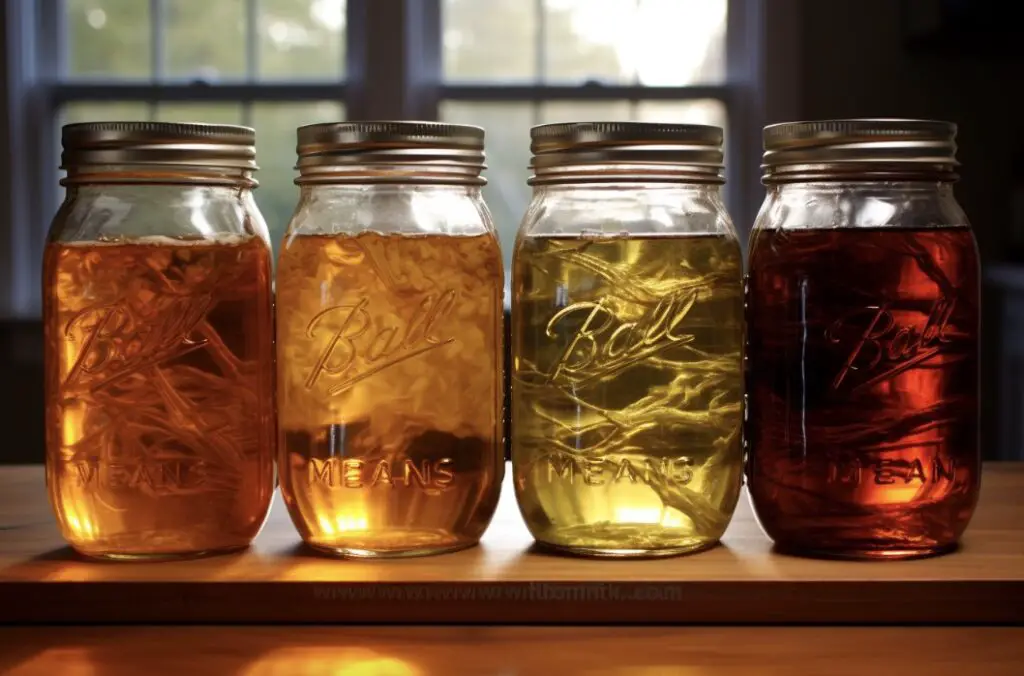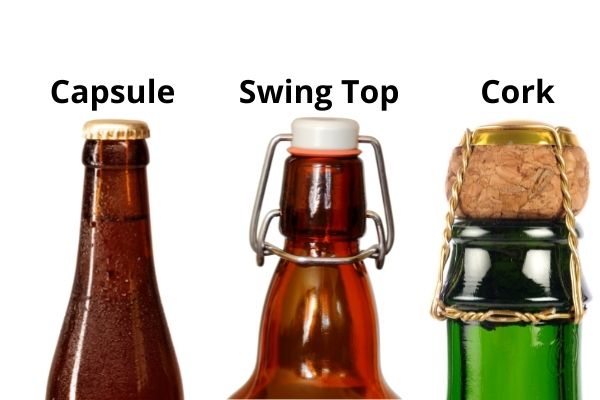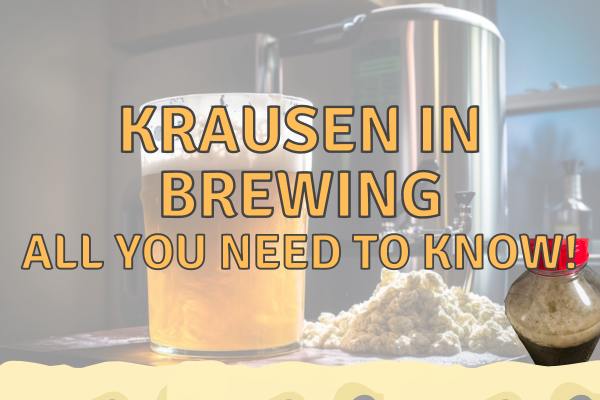Yes, kombucha is naturally carbonated.
The unique fermentation process that takes place during the brewing of kombucha results in the formation of carbon dioxide (CO2), which can give a fizzy, effervescent character, if enclosed in an airtight container (bottle carbonation).
In this blog post, we will delve into the world of kombucha and explore the factors that contribute to its natural carbonation, as well as how to control and enhance the fizziness of your homemade brew.
The Fermentation Process and Carbonation
A Quick Overview
Fermentation is a natural process that occurs when yeast and bacteria consume sugars and convert them into carbon dioxide, alcohol, and acids. In the context of kombucha, a symbiotic culture of bacteria and yeast (SCOBY) feeds on the sugar present in sweetened tea, producing a tangy, effervescent beverage with a myriad of touted health benefits.

Kombucha Fermentation: The Role of Yeast and Bacteria
The carbonation in kombucha is primarily a result of the yeast component of the SCOBY. Yeast breaks down the sugar into carbon dioxide and ethanol. The bacteria then consume the ethanol and produce acetic acid and other organic acids, which give kombucha its characteristic tangy flavor.
Carbonation in Kombucha: A Byproduct of Yeast Activity
As the yeast consumes the sugar during fermentation, it releases carbon dioxide as a byproduct. This carbon dioxide gets trapped in the liquid, creating the effervescence that is characteristic of kombucha. The natural carbonation of kombucha is therefore a direct result of the fermentation process.

Factors Affecting Kombucha Carbonation
A number of factors can influence the level of carbonation in your kombucha, including the fermentation time, temperature, and the composition of your SCOBY. Understanding these factors can help you control the fizziness of your finished brew.
Fermentation Time
The longer your kombucha ferments, the more carbon dioxide will be produced by the yeast. However, this does not necessarily mean that longer fermentation times will result in a fizzier beverage, as the CO2 can escape from the vessel if it is not airtight.
Fermentation Temperature
Temperature plays a crucial role in the fermentation process. Yeast activity increases at higher temperatures, which can result in greater carbon dioxide production and a fizzier brew. However, be cautious not to let your kombucha ferment at too high a temperature, as this can cause off-flavors and harm the SCOBY.
SCOBY Composition
The specific strains of yeast and bacteria present in your SCOBY can also impact the level of carbonation in your kombucha. Different strains of yeast produce varying amounts of carbon dioxide, which can affect the fizziness of your finished brew.
Enhancing Kombucha Carbonation: Bottle Fermentation
If you’re looking to boost the carbonation of your homemade kombucha, a second fermentation is the way to go.

This process involves adding sugars or fruit to the fermented kombucha and allowing it to ferment further in an airtight container, trapping the carbon dioxide and enhancing the fizziness of the beverage.
Choosing the Right Container for Second Fermentation
To ensure optimal carbonation during second fermentation, it’s important to use an airtight container.
Swing-top bottles or mason jars with airtight seals are good options for containing the buildup of carbon dioxide and maintaining the effervescence of your kombucha.

Just make sure the container is thick enough to withstand the pressure, otherwise the glass may explode!
Therefore I often recommend using a plastic bottle to begin with. Also beacuse you can feel the degree of carbonation by the firmness of the bottle.
Selecting the Right Sugars or Fruits for Second Fermentation
Adding sugars or fruits to your kombucha during second fermentation not only enhances carbonation but also imparts additional flavors to your brew. Popular choices include berries, citrus fruits, ginger, and herbal infusions.
Experiment with different combinations to find the perfect balance of fizz and flavor for your taste preferences.
In Conclusion
Kombucha is indeed a naturally carbonated beverage, with its effervescence resulting from the fermentation process involving yeast and bacteria in the SCOBY. By understanding the factors that affect kombucha carbonation and employing techniques such as second fermentation, you can control and enhance the fizziness of your homemade brew.
10 Facts About Kombucha Carbonation:
1. Kombucha is naturally carbonated due to the fermentation process.
2. Carbonation results from the yeast in the SCOBY consuming sugar and producing carbon dioxide.
3. Fermentation time, temperature, and SCOBY composition all influence kombucha carbonation.
4. A longer fermentation time can lead to more carbon dioxide production, but not necessarily a fizzier brew.
5. Higher fermentation temperatures can increase yeast activity and carbonation.
6. Different strains of yeast in the SCOBY can produce varying amounts of carbon dioxide.
7. A second fermentation can enhance kombucha carbonation and add flavor.
8. Use an airtight container during the second fermentation to trap carbon dioxide.
9. Adding sugars or fruits during the second fermentation can increase carbonation and impart additional flavors.
10. Popular flavor additions for second fermentation include berries, citrus fruits, ginger, and herbal infusions.
FAQs
Why is my kombucha so carbonated?
There are a few reasons why your kombucha might be overly carbonated. Firstly, the fermentation process may not have completed fully, leading to excess carbon dioxide production. This can happen if the brewing temperature was too low or if there was insufficient time for fermentation. Additionally, if you added too much sugar or used highly fermentable ingredients, it can result in excessive carbonation. Lastly, inadequate burping or venting of the bottles during the secondary fermentation can cause excessive carbonation.
How do you know if kombucha is over fermented?
You can determine if kombucha is over fermented by observing its taste, smell, and appearance. If the kombucha tastes extremely vinegary or overly sour, it is likely over fermented. Additionally, if it has a strong, unpleasant smell resembling nail polish remover, it may be over fermented. Visually, over fermented kombucha can appear darker in color and may have a murky or cloudy consistency.
How do you make kombucha less carbonated?
To make kombucha less carbonated, you can try the following methods:
1. Burp the bottles: Gently open the capped bottles to release excess carbonation. Repeat this process until the desired level of carbonation is achieved.
2. Refrigerate the kombucha: Cold temperatures slow down the fermentation process and reduce carbonation. Storing your kombucha in the refrigerator can help decrease its carbonation over time.
3. Use less sugar: During the fermentation process, the sugar is converted into carbon dioxide and alcohol. By reducing the amount of sugar used in the recipe, you can potentially decrease the carbonation level.
4. Shorten the fermentation time: The longer you ferment kombucha, the more carbonation it will develop. By reducing the fermentation time, you can lessen the carbonation.
Remember, carbonation levels can vary depending on the specific kombucha recipe and fermentation conditions. Experimentation is key to finding the perfect balance for your taste preferences.
How do you know when kombucha is done fermenting?
Kombucha is typically done fermenting when it reaches the desired level of acidity and carbonation. You can gauge this by taste-testing the kombucha. It should have a balanced sweet-tart flavor with a slight effervescence. Additionally, the SCOBY (symbiotic culture of bacteria and yeast) should have formed a new layer on top of the liquid. The fermentation time can vary depending on factors like temperature and personal preference, but it usually takes around 7-14 days.
How do you stop carbonation in kombucha?
To stop carbonation in kombucha, you can follow these steps:
1. Transfer your brewed kombucha into glass bottles with airtight lids, leaving some headspace at the top.
2. Place the bottles in the refrigerator, which slows down the fermentation process and reduces carbonation.
3. Keep the bottles refrigerated for a few days to a week, depending on your desired level of carbonation.
4. Open the bottles carefully to release any remaining carbonation before serving.
By refrigerating your kombucha, you can halt the fermentation process and minimize carbonation.
Is kombucha supposed to be carbonated?
Yes, kombucha is typically supposed to be carbonated. The carbonation is a natural byproduct of the fermentation process, where the SCOBY (symbiotic culture of bacteria and yeast) converts sugars into carbon dioxide and other compounds. However, some commercial brands may choose to remove the carbonation for various reasons, so not all kombucha products are carbonated.




